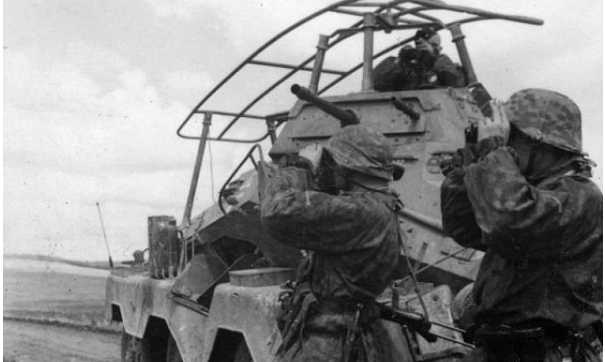Finnish volunteers in SS units took part in WWII Nazi atrocities, Finland says
After an Israeli historian’s appeal to Finland’s president to examine murder of Jews, country’s state archives look into the role of Finns in the Waffen-SS drive eastward in 1941-3
Finnish volunteer soldiers serving in the Nazi Waffen-SS units on the eastern front in World War II took part in the massacres of Jews, Russian prisoners of war, and civilians generally during the German march eastward through Ukraine and into the Caucasus from 1941 to 1943, a new report from the Finnish State Archives reveals.
“The sub-units and men of SS-Division Wiking engaged during the march into the Soviet Union and the drive through Ukraine and the Caucasus were involved in numerous atrocities,” the report, made public on Friday, relates.
“The diaries and recollections by the Finnish volunteers show that practically everyone among them must, from the very beginning, have been aware of the atrocities and massacres.”
A total of 1,408 Finns volunteered in the Waffen-SS from 1941 to 1943. They served in the well-armed 5th SS Panzer Division Wiking, one of the 38 divisions of the Waffen-SS distinguished by its complement of volunteer recruits from an assortment of northern European nations stretching from Estonia to Belgium and including the Scandinavian countries.
Between July and August 1941, at least 10,000 civilians, many of them Jews, are believed to have been killed by these units, the report notes, though it is hard to determine exactly where and when the Finnish volunteers were involved in killings and other atrocities.
The report quotes attorney Curt von Stackelberg’s comments at the Nuremberg trials that “more than six thousand civilians, Jews, were killed” from June to September in towns with ancient, storied Jewish communities, such as Lviv and Zhytomyr. In all, some 600,000 Jews were killed by SS forces or units under their control in the east from the start of Germany’s eastward push, dubbed Operation Barbarossa, in June 1941 until March 1942.
Many Finns were sympathetic to Nazi Germany during World War II, in part because of the 1939-40 Winter War with the Soviet Union. Finnish leaders, including in the military, permitted recruitment by Nazi Germany in Finland, and even tacitly supported it.
The report is necessarily vague and limited on some points because of a dearth of documentary evidence.
Seventy-six diaries of Finnish SS volunteers were consulted for the report, and reveal clear awareness of the atrocities underway around the soldiers, the report says, but that they were not “able to grasp the full picture” of the mass-extermination.
Many volunteers described atrocities they witnessed, but often briefly, without giving exact dates or figures, and speaking euphemistically in a way that led the report’s researchers to suggest they reflected the “emotional confusion” and “psychological rupture” caused by feeling of disgust at the atrocities they witnessed alongside “the loyalty they felt for their German commanders.” Taken together, these clashing impulses “disturbed and complicated their reactions,” and led in later years to “active efforts” in Finland to deny the volunteers’ participation in the Holocaust.
“Active efforts were made to project that the Finnish SS soldiers were mainly on the front line, unaware of the bigger picture,” National Archives Director General Jussi Nuorteva was quoted as saying in Finnish media on Friday.
The report is the product of a research effort launched by the Finnish State Archives after a January 4, 2018, appeal from Israel-based historian Efraim Zuroff to Finland’s President Sauli Niinisto to investigate the role played by Finnish volunteers in the Wiking division’s murder of Jews during the war. Research for the report began in May 2018.
Zuroff on Sunday hailed Finland for releasing the findings even if it was “painful and uncomfortable,” telling the Associated Press it was an “example of unique and exemplary civic courage.”
While the “diaries, recollections, notes, and documents” consulted for the research often gave only vague information on the events in which Finnish volunteers were active participants, “at least some of the cases show that Finnish volunteers did participate in carrying out atrocities against Jews and civilians,” the reports says.
These included: “Thor-Björn Weckström in the village of Novosilky/Nowosielce on 2.7.1941, the two unknown Finnish volunteers who shot two civilians in the village of Podhorylce in the first week of July 1941, the participation of Ilmari Autonen in the killing of a Soviet Commissar in Dnipropetrovsk in August 1941, and the killings in Toldzgun on 31.12.1942 under the command of the Finnish SSHauptsturmführer Karl-Erik Ladau. Volunteers Olavi Karpalo and Unto Boman (later Parvilahti) are likely to have been involved in atrocities, and Boman may also have had a leading role in the burning of a chapel in either Ozerna or some other location in that area, on 3.7. or 4.7.1941.”
Only eight Finnish SS veterans are still alive, according to the report, and none of those are specifically noted in the events explored by the research.
Initiated by the Finnish president’s office, the report was welcomed by the government on Friday. “We share the responsibility for ensuring that such atrocities will never be repeated,” said State Secretary Paula Lehtomäki.
